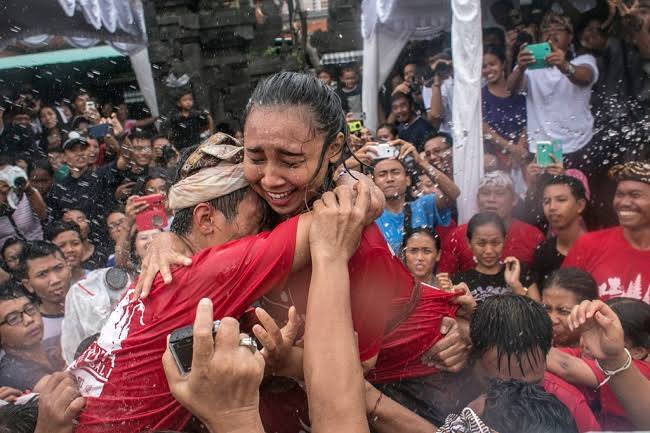Nestled in the heart of Kintamani, Bangli, Bali, Trunyan Village is renowned for its exclusive classical performance—the Barong Brutuk dance.
Unlike any other Balinese ritual, this dance is deeply embedded in local tradition and is presented only on very specific ceremonial occasions.
A Sacred Tradition Rooted in Belief
Local lore holds that the Barong Brutuk dance is a manifestation of sacred warriors, embodied by the divine figures Dewa Ratu Sakti Pancering Jagat and Ratu Ayu Dalem Pingit Dasar.
This unique spiritual belief is precisely why the dance is exclusive to Trunyan.
The performance is a testament to the village’s distinct cultural heritage, celebrating the dual nature of life as represented by the traditional roles of both men and women.
Costume and Symbolism
Central to the performance is the striking attire crafted entirely from banana leaves.
Dancers wear multiple layers of garments—meticulously dried and woven from these leaves—that drape elegantly around the waist, shoulders, and neck.
Notably, the dancer portraying the royal figure, known as Raja Brutuk, adorns a specially designed headpiece made from janur, while his fellow performers assume roles such as Sang Ratu, Patih, and the elder sister of Sang Ratu.
The varied costumes and masks, each with distinctive designs whose origins remain shrouded in mystery, serve to highlight the ritual’s symbolic representation of community dichotomy.
A defining feature of the dance is the whip-like movements, which carry deep meanings of purification and the repulsion of misfortune.
Additionally, the act of offering—symbolized when the dancers present parts of their costume to the audience—embodies a wish for prosperity and well-being among the viewers.
Rigorous Preparation and Rare Occurrence
Preparation for the Barong Brutuk is as meticulous as its performance.
Young men from the village, known as sekaa teruna, must undergo a 42-day period of sacred purification.
During this time, they are required to abstain from contact with women and collect banana leaves from the neighboring village of Pinggan—a task that underscores the ritual’s sacred nature.
This elaborate performance is not a frequent event; it is staged only once every two years during the Upacara Ngusaba Kapat.
This significant festival occurs on the full moon of the fourth month in the Balinese calendar and is held at Pura Pancering Jagat, the central temple of the traditional Trunyan community.
Ceremonial Process and Community Participation
The ceremony commences with a procession of unen-unen performers circling the temple walls thrice, brandishing ceremonial whips known as cemeti.
Their rhythmic motions set the stage for the arrival of the regal figures—Sang Raja, Sang Ratu, Patih, and the elder sister of Sang Ratu—who mimic these opening gestures.
As the dance unfolds, a village priest steps forward to present offerings and recite prayers, invoking blessings and protection for the community.
The audience, comprising active participants in the ceremony, approaches the performers to collect fallen banana leaves.
This act is symbolic of fertility, as the gathered leaves are later taken home and dispersed in the fields, contributing to agricultural prosperity.
In response, the dancers intensify their whip movements in a playful retribution against the “thieving” audience.
A Day of Ritual and Renewal
The full-day celebration culminates with a final ritual led by the priest, who bestows additional offerings on the dancers.
The Barong Brutuk performers then conclude the festivities by executing ancient movements, including gestures that mimic wild jungle fowl, encapsulating the timeless connection between nature and culture.
In Trunyan Village, the Barong Brutuk dance stands as a vibrant embodiment of tradition—a rare and sacred ritual that continues to reinforce communal bonds and celebrate the enduring spirit of Bali’s cultural heritage. (BT)
Image Source: X @kaliyuga49





